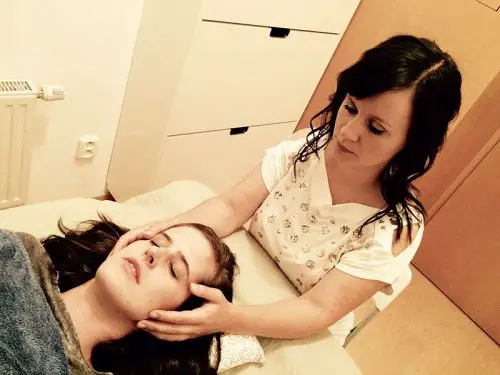Article reviewed and approved by Dr. Ibtissama Boukas, physician specializing in family medicine
Craniosacral therapy, developed in the 1970s by John Upledger, a doctor of osteopathy, is an alternative therapy where the practitioner applies gentle pressure aimed at treating several medical conditions.
Far from being unanimous from a scientific point of view, this form of therapy is still used throughout the world by certain osteopaths, massage therapists, myotherapists Or other.
In this article, we take stock of craniosacral therapy by exposing its benefits, indications, scientific shortcomings, and by explaining the course of a typical session.
Definition
Also called craniosacral therapy, craniosacral therapy is a form of non-invasive alternative treatment aimed at the relief of pain and physical and emotional tension.
Using excessively gentle hand pressure at the level of the head, the sacrum and the spine, the practitioner seeks to normalize the flow of cerebrospinal fluid (also called cerebrospinal fluid) in the central nervous system. This is said to remove “blockages” and improve the body's ability to heal.
Also, as the skull is made up of 22 bones, the subtle mobilization of these bones through craniosacral therapy would release some restrictions, and improve the functioning of the nervous system.
Scientific evidence
Certainly, there are several instances where patients who have tried craniosacral therapy have observed positive results on their pain, muscle tension or stress.
On the other hand, scientific research demonstrating a clinical effectiveness of this form of treatment are limited at present. Several studies on the subject are poorly conducted, or simply biased. It is therefore difficult to say that this approach has proven itself from a scientific point of view, and further studies are needed before confirming its effectiveness.
Likewise, the precepts on which craniosacral therapy is based are not based on no scientific basis. Indeed, studies have shown that it is impossible to find the craniosacral "pulse" or "rhythm", to precisely palpate the bones of the skull, to detect the movements of the bones of the skull, or even to correct the cerebrospinal flow (fundamental theoretical concepts part of this approach).
Precisely, one of the main therapeutic objectives of craniosacral therapy is to regulate the cerebrospinal flow. On the other hand, studies showed that the cerebrospinal fluid (CSF) could not be modified by manipulations at the level of the skull, especially when considering the minimal pressure exerted by the therapists.
It is more by breathing exercises (more precisely, respiratory movements of the trunk) that we could stimulate the circulation of the LCS.
Furthermore, craniosacral therapy is not not standardized with its practitioners. This means that different patients will get very different results depending on the therapist. This is due in particular to the fact that the practice is not regulated, and that the training is very heterogeneous.
Among the studies that are in favor of craniosacral therapy, the following results have been observed:
- Medium-term pain reduction in people with fibromyalgia (Source)
- Reduced stress and improved quality of life in people with fibromyalgia (Source)
- Potential benefits in people with asthma (Source)
- Improved quality of life and urinary function in people with multiple sclerosis (Source)
Indications and contraindications
Because it uses a gentle approach, this form of therapy can be used by almost anyone. More specifically, therapists using this method are often called upon to treat the following conditions:
- several forms of chronic pain (lumbago and neck pain)
- fibromyalgia
- several musculoskeletal disorders
- migraine headaches
- neuralgia
- sinusitis
- asthma
- certain neurological and degenerative conditions
- chronic fatigue
- The jaw pain
- several emotional disorders (depression, stress, anxiety, etc.)
On the other hand, it is possible that pressures at the level of the skull – however slight – can be potentially damaging for the patient. This is the case in the following situations:
- Recent concussion
- Structural defects of the brain
- cerebral edema
- aneurysm
- Blood clots
- Epistaxis (nose bleeds)
- Baby under 2 years old
- Etc
Course of a session
A craniosacral therapy session is quite similar to a massage session, except that the patient usually wears their clothes on.
La initial consultation allows the therapist to know your medical condition, symptoms, injury history, etc. He will then examine the problem areas and then begin the treatment, most often in a calm environment (soft muscle and dim light) aimed at promoting relaxation.
Essentially, craniosacral therapy uses gentle pressure techniques to correct potential disturbances and restrictions of the myofascial system. A relaxing environment is maintained throughout the session.
Empirically, patients report feeling unique sensations like these:
- head pulsation
- tingling sensation in the body
- feeling of hot or cold
- relaxation and feeling of well-being
- drowsiness
- emotional overload
My name is Anas Boukas and I am a physiotherapist. My mission ? Helping people who are suffering before their pain worsens and becomes chronic. I am also of the opinion that an educated patient greatly increases their chances of recovery. This is why I created Healthforall Group, a network of medical sites, in association with several health professionals.
My journey:
Bachelor's and Master's degrees at the University of Montreal , Physiotherapist for CBI Health,
Physiotherapist for The International Physiotherapy Center


